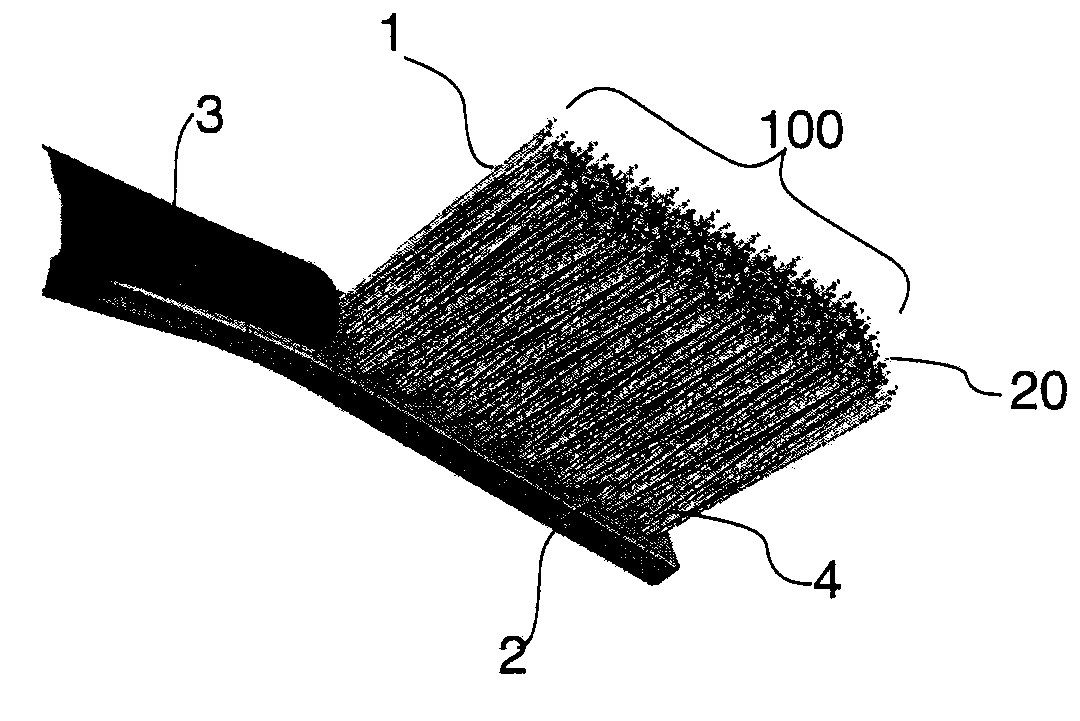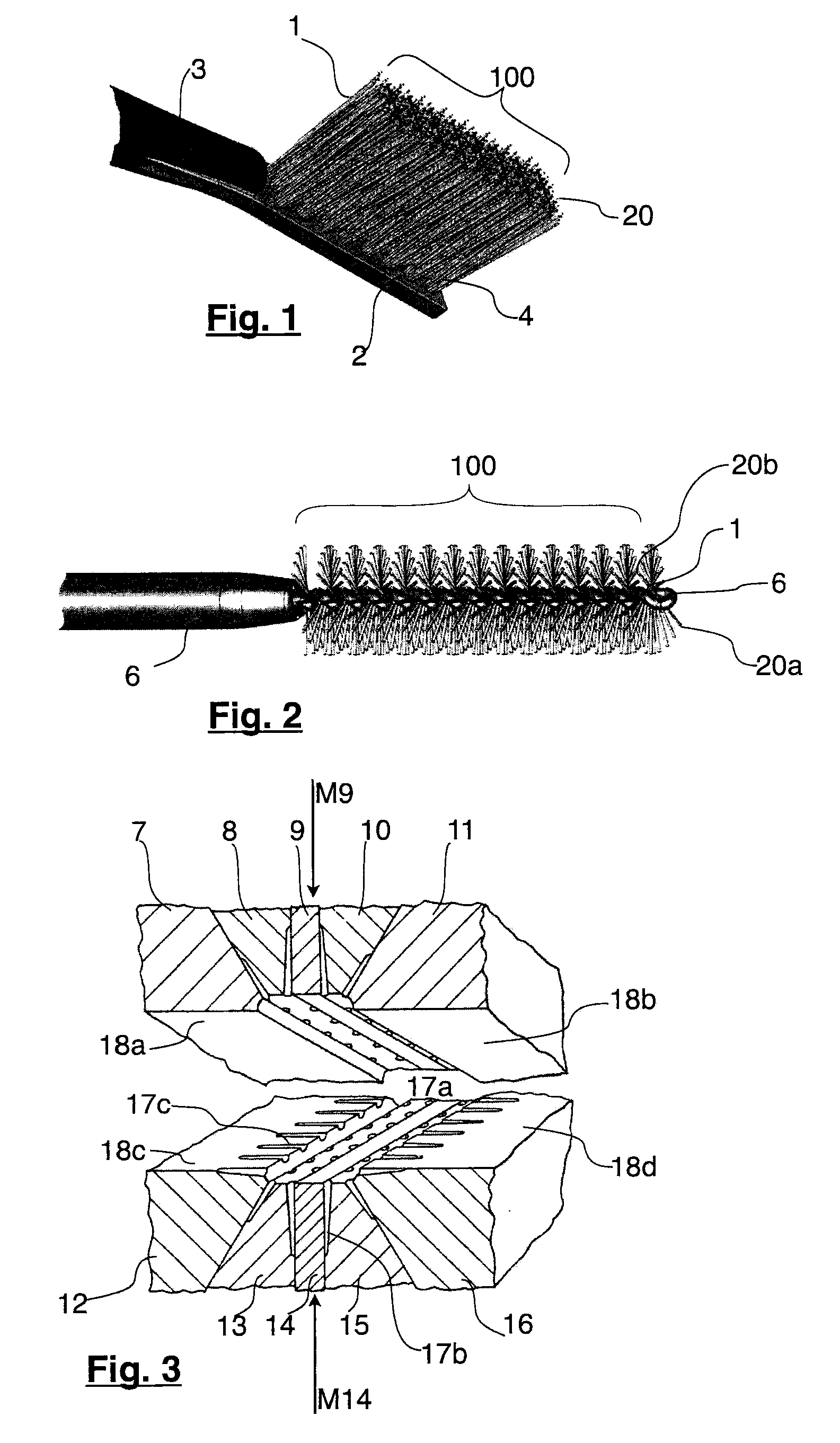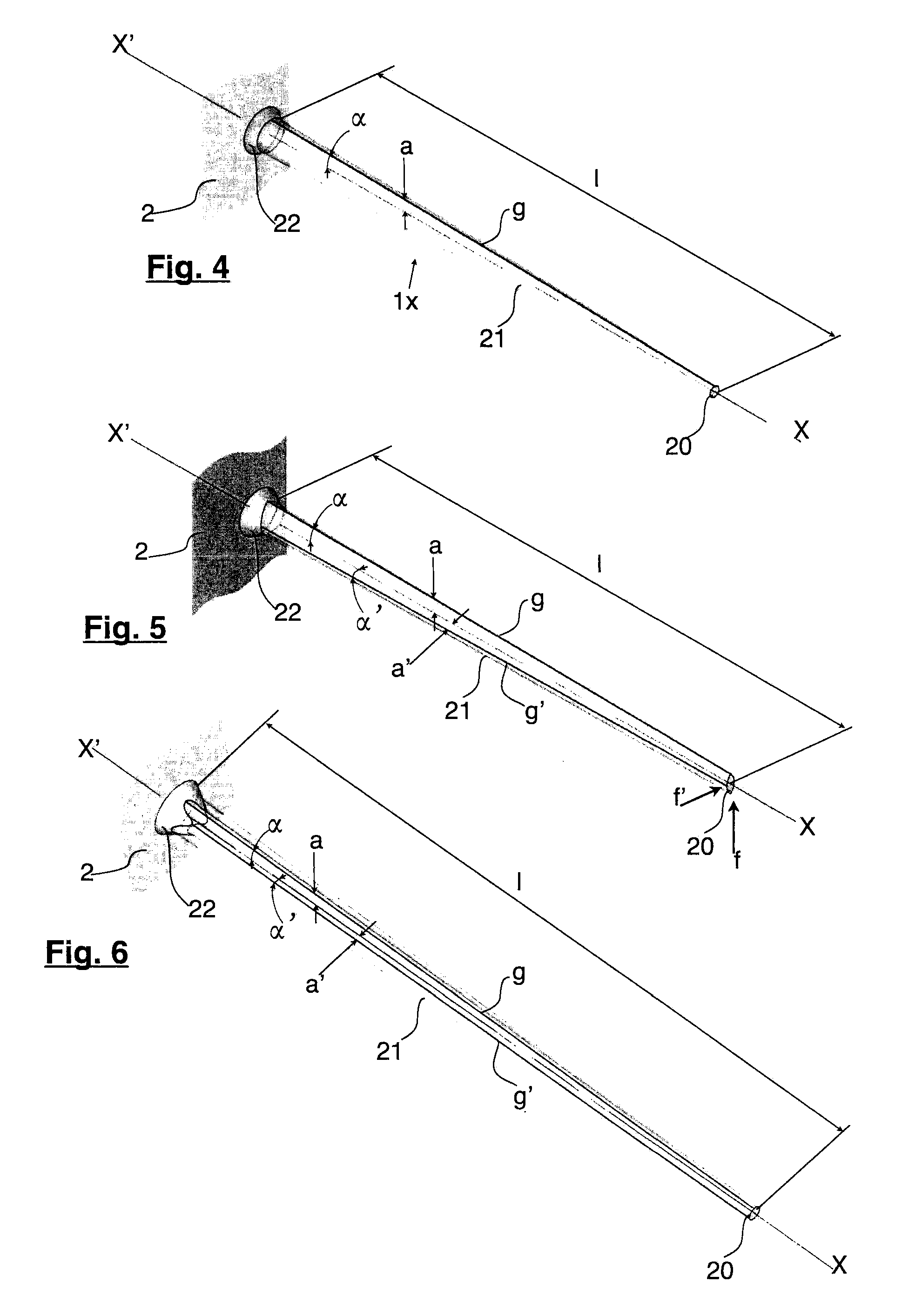This method is slow and expensive since the tufts of bristles are inserted successively one by one by a
machine.
Mass production requires a lot of labor or many automatic machines as well as sophisticated checking equipment to verify that the
brush is complete and free from defects.
In use, these brushes are effective for scrubbing, cleaning or applying a liquid substance such as paint or
varnish, but are not suitable for combing in a precise manner since the bristles are tightly packed together in the tufts and allow entry into the fibers to be separated with difficulty.
In addition, the whole is not uniform since the bristles are more tightly packed in the middle of each tuft than on the periphery and the empty spaces between each tuft create discontinuities.
The varied materials used to make up the
handle, bristles, staple or
adhesive make it difficult to recycle such a
brush at the end of use.
This method is slow and difficult to implement since it consists of a series of operations that are tricky to reproduce on a unit basis on each
brush.
The number of bristles and their rigidity can vary substantially during production, the resilience of the
metal wire and its elasticity can influence the shape of the twist, and the wear of the
cutting tools that have the task of leveling off the end of the bristles also leads to variations and a risk of uncut bristles.
Temperature variations and clogging up due to dust also have a negative effect on production consistency.
In practice, the complexity of this manufacturing method and the variations resulting therefrom do not allow absolutely identical brushes to be obtained.
In use, these brushes are effective for scrubbing, cleaning or applying a semi-
solid substance such as
mascara, but are not suitable for a precise and delicate use on account of the variations caused by the manufacturing method.
The combing performance of such a brush is poor since the distribution of the bristles in a spiral cannot produce a regular spacing between the bristles.
The varied materials used to make up the
handle, twisted wire and bristles make it difficult to recycle such a brush at the end of use.
The major drawback of these last brushes is a relatively crude configuration with relatively large, conical and not very flexible bristles which do not permit delicate and precise brushing or combing.
This is because it is impossible to obtain, by molding, bristles as fine as the fibers obtained by
extrusion and drawing as in the other categories of brush described previously.
This lack of
fineness is as much due to the limitations known to persons skilled in the art in the implementation of
metal injection molds, as to the technical limitations of
thermoplastic material injection methods.
The traditional methods for removing
metal for making the very fine cavities corresponding to forming bristles in the mold suffer from a lack of precision and do not allow a perfectly
smooth surface finish to be obtained.
Drilling or milling leaves serrations, and the
electrode sinking spark
erosion method leaves many small craters which will, on this small scale, be very harmful to the molding.
It is also very difficult to polish a multiplicity of small cavities.
Furthermore, the separating partitions between these cavities cannot be very thin without risking weakening the mold.
1) pressure drops related to the
viscosity of the liquid material and friction on the surface of the mold become greater, the narrower the cavity;
2) cooling of the material through contact with the metal of the mold tends to reduce its fluidity and set it prematurely; and
3) the air present naturally in the cavity has a tendency to be compressed at the bottom of the cavity during filling of the mold by the
molten material, causing heating that may go as far as burning the exposed surface of the material. This results in an incomplete and blackened part, and carbon deposits that accumulate on the functional surfaces of the mold, progressively spoiling the quality of the production.
A broken bristle in the cavity will make this partially or totally unusable and will force long and expensive dismantling for cleaning.
This proposal runs counter to obtaining a precision brush since the conical shape increases the cross-section of the base of the bristle, which reduces its flexibility and increases the distance between the centers of two consecutive bristles.
This method requires molding the support
handle with precise apertures, before molding the bristles in a second injection operation, which slows down production and increases the costs, especially for small-sized brushes, which do not require a handle molded in another material.
Moreover, this technology imposes a relatively
large distance between the bristles since the apertures in the support must have sufficiently thick profiles to be able to withstand the second injection for forming the bristles.
For these reasons, this invention does not allow a precision brush to be made at low cost.
However, this configuration has the same negative effects for obtaining a precision brush as the conical shape.
Although efficient, these devices have the drawback of having sharp corners along the edge of the teeth and a pointed end which can injure the user, or at least suggest to them a notion of danger, more particularly for cosmetic use on the face, close to the eyes.
The repetitiveness of the movement at each cycle inevitably causes surface wear of the
moving parts, which after prolonged use produces small gaps into which the material will enter, causing burrs along the edges of the bristles, variable as a function of the
temperature and pressure parameters.
Furthermore the removal of the air present in the die cavity before filling not being channeled, it takes place automatically through the gaps between the parts constituting the bristle-molding parts, more or less efficiently depending on the wear and heating of the mold.
As the same flow of
molten material is injected into the entire mold, this results in great difficulty in adjusting sufficient pressure to push the material to the end of each of the bristles on each of the die cavities without causing the appearance of burrs on any one of the bristles.
The molding burrs on the bristles are altogether harmful to precision brushing or combing.
completely
close up the interval between two teeth with a “web” of plastic, therefore reducing the effectiveness of the device;
Despite the
good control of certain of the technologies mentioned above, the prior art does not allow simple precision brushing or combing devices to be made industrially at low cost.
As the
hardness of the steel does not permit conventional
machining by removal of slivers, the plates of the block
assembly are shaped by a spark
erosion method or more precisely as regards the cavities intended to form the internal surface of the cavities corresponding to the molding of the main portion of the bristles, by wire spark erosion.
The fixing to one another of the plates constituting a block
assembly is particularly tricky because of the small dimensions of the assembly and the bulk of the ejection mechanisms and the venting plates or bars.
The tip of a natural bristle used in traditional brush-making, or “[fleur du poil]”, has a cross-section distinctly less than 0.1 mm, perhaps even less than 0.01 mm, and it is not possible with current technologies to produce such
fineness directly by molding of
thermoplastic material.
When the brushing or combing device is molded in a flexible material such as
elastomer (TPE), or a material with a
poor memory such as a
polyolefin (PP or PE), the
residual deformation after mechanical curving risks being zero, but also risks being small or irregular.
 Login to View More
Login to View More 


